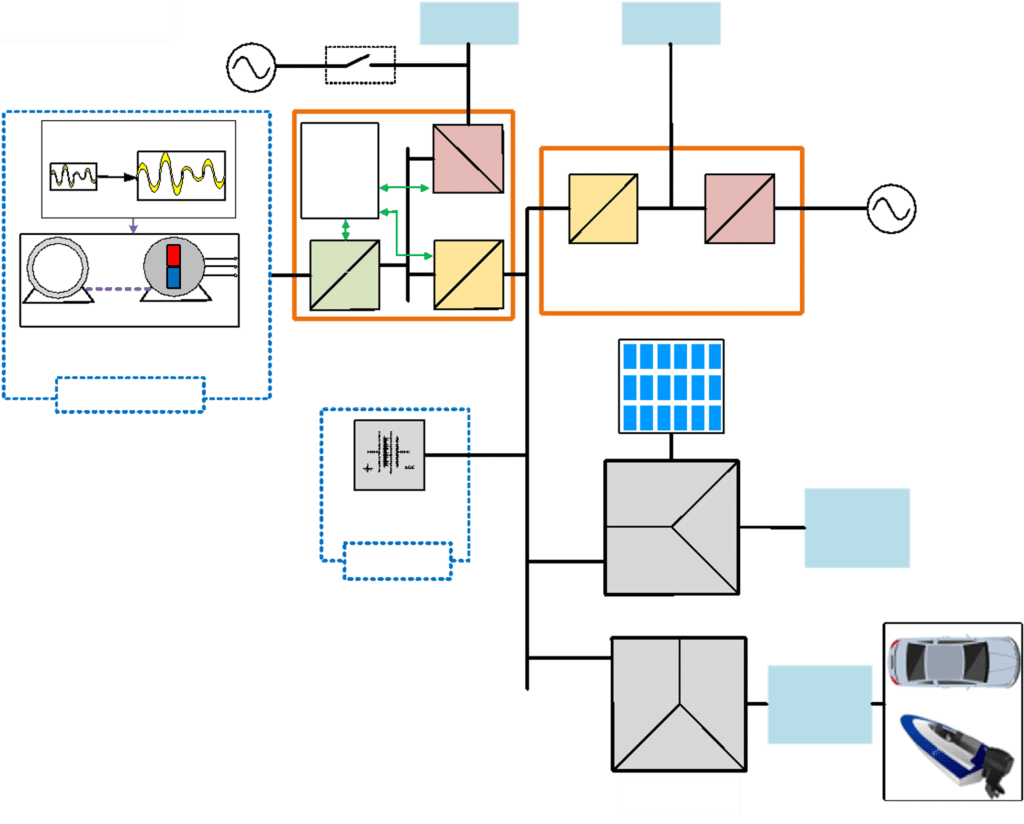Coastal Studies Institute (CSI) Project

Project Description:
As part of this project, a flexible emulator testbed for testing microgrids has been developed. The core hardware microgrid units, including power converters, energy storage systems, power sources, and various load types, have been implemented inside the Typhoon Hardware-In-the-Loop (HIL) system. The individual controllers for various converters including an MPPT controller, bidirectional battery charging controller, control for the grid-tied and grid-forming inverters, controller for the WEC power rectifier, etc have been developed. The control algorithms and associate controllers has been tested in eight steps, with the final stage being the integration of those controllers into the testbed using external microcontroller boards. As the first case study, a complete microgrid consisting of the 5 kW MPC modules developed as part of the ’21-’22 project serving as the core MPC and selected commercial hardware modules serving as a modular microgrid expansion has been partially incorporated in the testbed. The Typhoon based hardware testbed will allow testing the unique challenges of standalone and grid-connected microgrids, WEC generation, energy storage, and specific load scenarios by running steady-state and transient events such as grid faults, loss of generation, the addition of loads, overload, etc. After the expected operation is confirmed, the testbed can be confidently utilized to generate an optimum microgrid design.
The general structure of the proposed microgrid with several power converters emulated in the HIL testbed is illustrated in Figure 1. The HIL testbed is organized into three layers. The first layer utilizes the real-time HIL emulator Typhoon to simulate the model of microgrid hardware units in real time. The second layer utilizes TI DSPs (e.g., LAUNCHXL-F28379D) to control an individual or a group of modeled converters after connecting the DSPs to the real-time HIL emulator. The third layer is the communication layer based on TI DSP BeagleBone hardware. Simulation models and controllers for each converter shown in Figure 1 were developed in the project’s first phase. The commercially available Stability 30C3 MPC has been acquired, and preliminary testing of the converter is complete. Finally, representative converters from the proposed microgrid have been emulated in the real-time HIL emulator (Typhoon) along with the implementation of their controllers in the TI DSPs. The combined operation of multiple TI DSP controllers in the real-time hardware CHIL environment is complete. This CHIL-based real-time testbed implemented with Typhoon and TI DSP controller has been deployed and will be utilized in Year 2023-24 for designing the modular AMEC microgrid for upgrading Jennette’s Pier CSI Testbed.
Project Start Date: 06/01/2022
Project Due Date: 06/01/2024
Project Status: On-going
Project PI: Iqbal Husain
Project Co-PI: Zeljko Pantic
Project Objectives:
Task 1: CHIL-Based Real-Time Testbed Development (Task Progress: 100%)
- Modular DC/DC, DC/AC, and AC/DC converters, energy resources, and loads are to be modeled.
- The models created are programmed in the Typhoon HIL platform to emulate the power stage of the microgrid in real time.
- Continuous-time domain controllers are to be designed for all the modeled converters. After verifying their stable operation, the controllers are discretized and implemented in TI DSP boards rather than inside the Typhoon HIL real-time environment. The DPS boards should be connected to Typhoon HIL to retest the controllers in real time.
- Individually controllable modular converters will be aggregated to build up the real-time simulation model of the marine microgrid. Distributed control hierarchy will be explored utilizing the available communication hardware layer.
- The steady-state operation and transient conditions test of the marine microgrid will be performed on the Typhoon HIL+DSP boards set up.
Task 2: Hardware Validation of the CHIL-Based Testbed (Task Progress: 100%)
- The lab-built 5-kW MPC (see Figure 1), a selected 30-kW MPC (i.e., Stability from CE+T), the FREEDM battery, source, and load units will be assembled to create the microgrid experimental setup.
- The controller system tested and validated in Task 1 using the TI DSPs and the real-time simulator TYPHOON will be tested in the experimental setup for continuous steady-state operation.
- After validating the controller for continuous steady-state operation, the system of control boards (i.e., TI DSPs) will be tested on the experimental hardware setup for various transient and fault events.
Task 3: Testbed Deployment for Design and Planning of the Modular AMEC Microgrid (Task Progress: 95%)
- Models of distributed energy resource (WEC/solar) generation and load profiles will be developed for the 30 kVA AMEC microgrid. The modular converters developed in Task 1 will be aggregated to model a 30 kVA hybrid AC/DC microgrid system to interface the grid and facilitate bidirectional power flow.
- Optimization algorithms will be utilized to size the microgrid components of the model in Task 3.1.
- A microgrid power management controller (PMC) enabling black-start with the available storage will be developed for the 30-kVA AMEC microgrid in Task 3.1 for implementation in the real system.
Project Collaborators and Sponsors:
